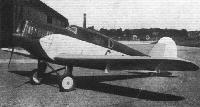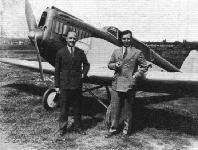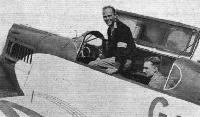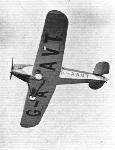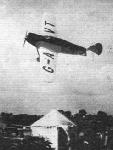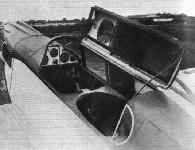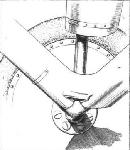
Варианты
- Hendy - Hendy 302 - 1929 - Великобритания
- Parnall - Hendy Heck - 1934 - Великобритания
- Parnall - Model 382 / Heck III - 1939 - Великобритания
Hendy 281 Hobo и Hendy 302
<...>
Hendy 302, также построенный в единственном экземпляре, представлял собой двухместный кабинный моноплан, построенный в 1929 году компанией "George Parnall & Company Ltd" по проекту Бэзила Хендерсона.
Описание:
- Hendy 281 Hobo и Hendy 302
- Flight, August 1930
THE "HENDY" 302 - Flight, July 1934
NEW AEROPLANES IN KING'S CUP RACE
Фотографии
-
Flight 1930-08 / Flight
Регистрационный номер: G-AAVT [20] Первоначально Hendy 302 оснащался двигателем Cirrus Hermes I мощностью 105 л. с. (78 кВт), но затем последний заменили на Cirrus Hermes IV мощностью 130 л. с. (97 кВт), а также перепроектировали кабину и установили шасси с обтекателями колес. Модифицированная машина стала называться Hendy 302A.
DESIGNED by Mr. Basil B. Henderson, this new machine has been but recently produced, and is something of a "dark horse." Last year Mr. Henderson produced the "Hobo," incorporating a novel form of wing construction, and the "302" is a development of the smaller machine, being a cabin two-seater. As the picture shows, it is a low-wing monoplane. The occupants are placed in tandem. The engine is a Cirrus-Hermes. -
Flight 1930-08 / Flight
Регистрационный номер: G-AAVT [20] HENDY MEN: On the left, Capt. E. W. Percival, and on the right, Mr. Basil B. Henderson.
-
Flight 1930-08 / Flight
Регистрационный номер: G-AAVT [20] THE BUSINESS END: The cowling of the "Hermes"engine in the "Hendy" 302 has been carefully designed and although totally enclosed, the engine keeps remarkably cool.
-
Flight 1930-07 / Flight
Регистрационный номер: G-AAVT [20] THE HENDY 302: This machine would have stood a very good chance in the King's Cup Race had compass trouble not intervened. It is unique as our only low-wing cabin monoplane.
-
Flight 1931-06 / Flight
Регистрационный номер: G-AAVT [20] THE HIGH-LIMIT. Mr. Percival, the last man away, loses no time in getting his Hendy 302 (Hermes II) off the ground.
-
Flight 1930-07 / Flight
Регистрационный номер: G-AAVT [20] Capt. Percival sitting in the opened cockpit of his Hendy 302, which he flew in the King's Cup Race. He made exceptionally good time to Manchester. This machine offers a new version of comfort to private owners, and appears to combine a low landing speed with a high top speed and, moreover, has excellent visibility from the pilot's seat.
-
Flight 1931-06 / Flight
Регистрационный номер: G-AAVT [20] SEEN AT HESTON: Mr. Percival gets into his comfortable and fast Hendy 302.
-
Flight 1930-07 / Flight
Регистрационный номер: G-AAVT [20] AT MRS. BALDWIN'S NATIONAL BIRTHDAY TRUST FUND MEETING AT HANWORTH: The photograph shows some of the faster machines lined up for the start.
Другие самолёты на фотографии: De Havilland Puss Moth / D.H.80 - Великобритания - 1929
-
Air Enthusiast 1994-12 / M.Lowe - Island Hopper
Регистрационный номер: G-AAVT [20] G-ABLI in varied company. Note the single porthole behind the pilot’s cabin - was this prior to the Karachi flight or afterwards? Recognisable among the aircraft in the photograph are Cierva C24 G-ABLM (withdrawn from use December 1934); Puss Moth; Dessoutter (either G-ABFO or G-ABRN); Hendy 302 G-AAVT; Junkers F.13ge G-ABDC (sold in Sweden December 1934) and Comper Swift G-ABPE. Can anyone name and date the occasion?
Другие самолёты на фотографии: Cierva/De Havilland C.24 - Великобритания - 1931Comper Swift / CLA.7 - Великобритания - 1930De Havilland Puss Moth / D.H.80 - Великобритания - 1929Junkers F 13 - Германия - 1919Koolhoven FK-41 - Нидерланды - 1928Spartan Cruiser - Великобритания - 1932
-
Flight 1930-08 / Flight
Регистрационный номер: G-AAVT [20] This view from below shows the neat way in which the centre-section of the wing fairs into the fuselage.
-
Flight 1930-08 / Flight
Регистрационный номер: G-AAVT [20] THE "HENDY" 302: Flying Views from below and above
-
Air-Britain Archive 1980-02
Регистрационный номер: G-AAVT [20] The Hendy 302 G-AAVT in what appears to be the later 302A configuration with inverted Cirrus Hermes IV.
G-AAVT Hendy 302. Photo shows the aircraft in its original form with upright engine (low mounted air-screw), green & cream colour scheme and no spats. The later, lower, cowling gave the aircraft a more Percival Gull-like appearance. -
Flight 1931-04 / Flight
Регистрационный номер: G-AAVT [20] An aerial view of the Hendy 302 [Hermes II) flying over the Sussex Downs. This machine is the fastest cabin light aircraft available for private owners and cruises at 125 m.p.h. Built by the Hendy Aircraft Co., of Shoreham-by-Sea, Sussex, this is an extremely fascinating aircraft.
-
Flight 1930-09 / Flight
Регистрационный номер: G-AAVT [20] Capt. Percival (third on the Grosvenor Cup) on his left
-
Flight 1930-08 / Flight
Регистрационный номер: G-AAVT [20] -
Flight 1937-09 / Flight
Регистрационный номер: G-AAVT [20] The Hendy 302 has been used as a flying test bed for the new Cirrus Major 150 engine.
-
Jane's All the World Aircraft 1980 / Encyclopedia of Aviation - Aircraft A-Z - v4
Регистрационный номер: G-AAVT [20] Hendy 302.
-
Flight 1930-08 / Flight
Регистрационный номер: G-AAVT [20] THE "HENDY" 302: The mounting of the "Hermes" engine is very simple, and the attachment to fuselage corners is by stirrup plates.
-
Flight 1930-08 / Flight
Регистрационный номер: G-AAVT [20] THE "HENDY" 302 Details of the wing construction. Note the lattice type drag bracing of the main spars.
-
Flight 1930-08 / Flight
Регистрационный номер: G-AAVT [20] THE CABIN OF THE "HENDY" 302: This is very comfortable, with plenty of leg and elbow room. The view is good, much better than one would expect from the external appearance.
-
Flight 1930-08 / Flight
Provision is made, on the "Hendy" 302 for the support of a jack under the axle.
-
Flight 1930-08 / Flight
THE "HENDY" 302: Mr. Henderson has designed a novel form of main spar bracing, in which the spars are braced top and bottom by lattice strips, anchored at their ends and points of intersection to three-ply gussets.
-
Flight 1930-08 / Flight
Hendy 302 Cirrus "Hermes" Engine
- Фотографии
